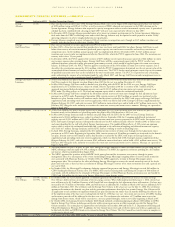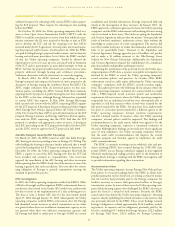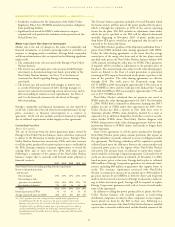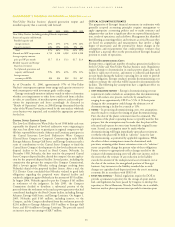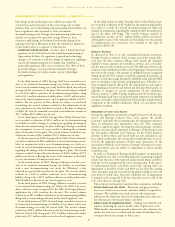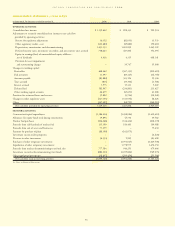Entergy 2006 Annual Report Download - page 60
Download and view the complete annual report
Please find page 60 of the 2006 Entergy annual report below. You can navigate through the pages in the report by either clicking on the pages listed below, or by using the keyword search tool below to find specific information within the annual report.
ENTERGY CORPORATION AND SUBSIDIARIES 2
2000066
44
Non-Utility Nuclear business’ planned generation output and
installed capacity that is currently sold forward:
2007 2008 2009 2010 2011
Non-Utility Nuclear (including pending Palisades acquisition):
Percent of capacity sold forward:
Bundled capacity and
energy contracts 21% 27% 27% 27% 26%
Capacity contracts 66% 39% 26% 9% 3%
Total 87% 66% 53% 36% 29%
Planned net MW in operation 4,732 4,998 4,998 4,998 4,998
Average capacity contract
price per kW per month $1.7 $1.4 $1.3 $1.7 $2.0
Blended Capacity and Energy
(based on revenues):
% of planned generation and
capacity sold forward 93% 80% 60% 39% 23%
Average contract
revenue per MWh $50 $54 $58 $53 $47
As of December 31, 2006, approximately 97% of Non-Utility
Nuclear’s counterparty exposure from energy and capacity contracts is
with counterparties with investment grade credit ratings.
Entergy continually monitors industry trends in order to determine
whether asset impairments or other losses could result from a decline
in value, or cancellation, of merchant power projects, and records pro-
visions for impairments and losses accordingly. As discussed in
“Results of Operations” above, in 2004 Entergy determined that the
value of the Warren Power plant owned by the non-nuclear wholesale
assets business was impaired, and recorded the appropriate provision
for the loss.
CENTRAL STATES COMPACT CLAIM
The Low-Level Radioactive Waste Policy Act of 1980 holds each state
responsible for disposal of low-level radioactive waste originating in
that state, but allows states to participate in regional compacts to ful-
fill their responsibilities jointly. Arkansas and Louisiana participate in
the Central Interstate Low-Level Radioactive Waste Compact
(Central States Compact or Compact). Commencing in early 1988,
Entergy Arkansas, Entergy Gulf States, and Entergy Louisiana made a
series of contributions to the Central States Compact to fund the
Central States Compact’s development of a low-level radioactive waste
disposal facility to be located in Boyd County, Nebraska. In
December 1998, Nebraska, the host state for the proposed Central
States Compact disposal facility, denied the compact’s license applica-
tion for the proposed disposal facility. Several parties, including the
commission that governs the compact (the Compact Commission),
filed a lawsuit against Nebraska seeking damages resulting from
Nebraska’s denial of the proposed facility’s license. After a trial, the
U.S. District Court concluded that Nebraska violated its good faith
obligations regarding the proposed waste disposal facility and
rendered a judgment against Nebraska in the amount of $151 million.
In August 2004, Nebraska agreed to pay the Compact $141 million
in settlement of the judgment. In July 2005, the Compact
Commission decided to distribute a substantial portion of the
proceeds from the settlement to the nuclear power generators that had
contributed funding for the Boyd County facility, including Entergy
Arkansas, Entergy Gulf States, and Entergy Louisiana. On August 1,
2005, Nebraska paid $145 million, including interest, to the
Compact, and the Compact distributed from the settlement proceeds
$23.6 million to Entergy Arkansas, $19.9 million to Entergy Gulf
States, and $19.4 million to Entergy Louisiana. The proceeds caused
an increase in pre-tax earnings of $28.7 million.
CRITICAL ACCOUNTING ESTIMATES
The preparation of Entergy’s financial statements in conformity with
generally accepted accounting principles requires management to
apply appropriate accounting policies and to make estimates and
judgments that can have a significant effect on reported financial posi-
tion, results of operations, and cash flows. Management has identified
the following accounting policies and estimates as critical because they
are based on assumptions and measurements that involve a high
degree of uncertainty, and the potential for future changes in the
assumptions and measurements that could produce estimates that
would have a material effect on the presentation of Entergy’s financial
position or results of operations.
NUCLEAR DECOMMISSIONING COSTS
Entergy owns a significant number of nuclear generation facilities in
both its Utility and Non-Utility Nuclear business units. Regulations
require Entergy to decommission its nuclear power plants after each
facility is taken out of service, and money is collected and deposited
in trust funds during the facilities’ operating lives in order to provide
for this obligation. Entergy conducts periodic decommissioning cost
studies to estimate the costs that will be incurred to decommission the
facilities. The following key assumptions have a significant effect on
these estimates:
■COST ESCALATION FACTORS – Entergy’s decommissioning revenue
requirement studies include an assumption that decommissioning
costs will escalate over present cost levels by annual factors
ranging from approximately CPI-U to 5.5%. A 50 basis point
change in this assumption could change the ultimate cost of
decommissioning a facility by as much as 11%.
■TIMING – In projecting decommissioning costs, two assumptions
must be made to estimate the timing of plant decommissioning.
First, the date of the plant’s retirement must be estimated. The
expiration of the plant’s operating license is typically used for this
purpose, but the assumption may be made that the plant will be
relicensed and operate for some time beyond the original license
term. Second, an assumption must be made whether
decommissioning will begin immediately upon plant retirement,
or whether the plant will be held in “safestore” status for later
decommissioning, as permitted by applicable regulations. While
the effect of these assumptions cannot be determined with
precision, assuming either license extension or use of a “safestore”
status can possibly change the present value of these obligations.
Future revisions to appropriately reflect changes needed to the
estimate of decommissioning costs will affect net income, only to
the extent that the estimate of any reduction in the liability
exceeds the amount of the undepreciated asset retirement cost at
the date of the revision, for unregulated portions of Entergy’s
business. Any increases in the liability recorded due to such
changes are capitalized and depreciated over the asset’s remaining
economic life in accordance with SFAS 143.
■SPENT FUEL DISPOSAL – Federal regulations require the DOE to
provide a permanent repository for the storage of spent nuclear
fuel, and legislation has been passed by Congress to develop this
repository at Yucca Mountain, Nevada. Until this site is available,
however, nuclear plant operators must provide for interim spent
MANAGEMENT’S FINANCIAL DISCUSSION and ANALYSIS continued





